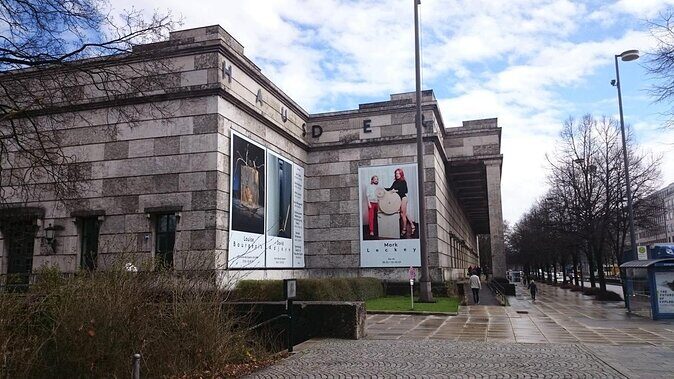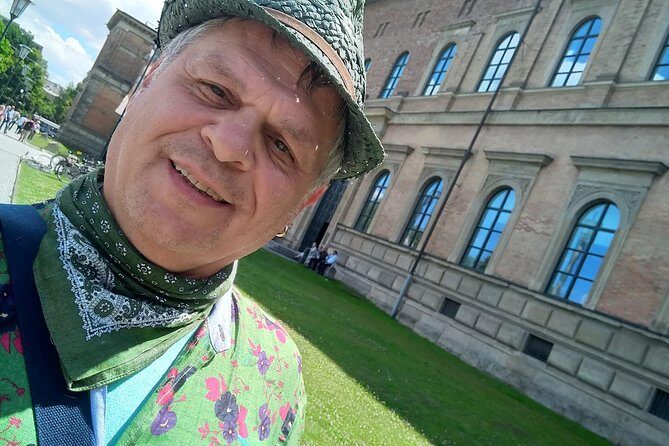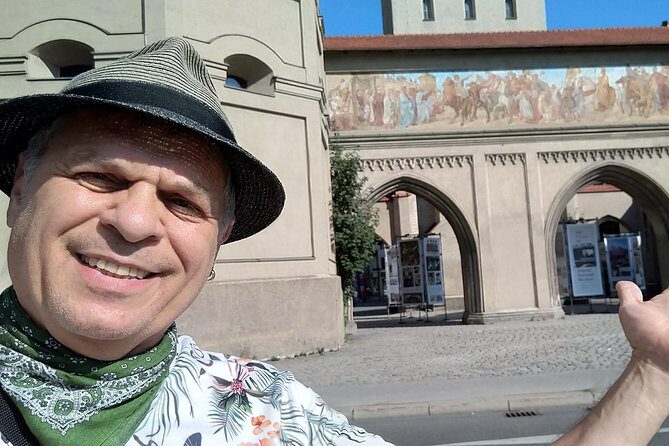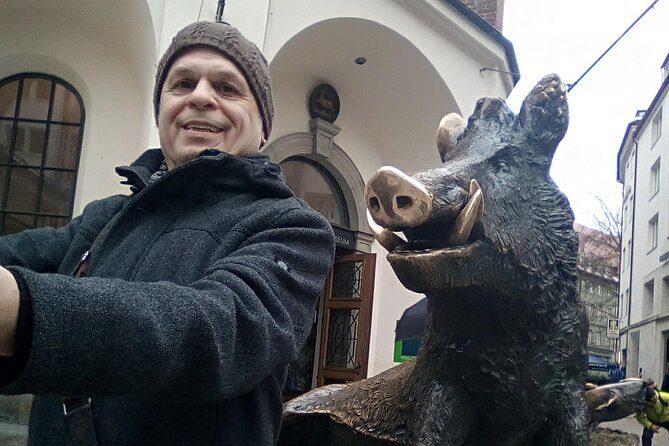A Closer Look at Munich’s WWII Past: Third Reich Small Group Walking Tour
This 2 to 3-hour walking tour costs around $109.86 per person, and it’s perfect for travelers eager to understand Munich’s role during the rise and fall of the Third Reich. Led by a passionate and knowledgeable guide, the tour takes you through a carefully curated route, starting at Konigsplatz and ending near Haus der Kunst. Along the way, you’ll visit pivotal sites such as Hitler’s Office, the Justice Palace, and Odeonsplatz—each with its own story to tell.
What we love most about this experience is the small group size, which ensures a more personal and engaging conversation. The guide’s storytelling makes complex history accessible and vivid. Another highlight is the well-chosen itinerary, which balances the somber weight of WWII with insightful context about Munich’s role within the Nazi regime.
A possible consideration is that the tour is mostly pedestrian, so comfortable shoes are a must. Also, since some sites require tickets, you might want to plan accordingly if you’re interested in exploring certain museums or buildings further.
This tour is especially suited for history buffs, curious travelers, or anyone wanting a meaningful, guided overview of Munich’s dark past without the hassle of planning multiple visits. If you prefer a compact, thoughtfully curated experience with a personable guide, this tour is likely to satisfy.
Key Points

- In-depth historical route: Covers major WWII sites in Munich, from Konigsplatz to Odeonsplatz.
- Small group advantage: More personalized interaction with the guide.
- Authentic insights: Learn about Hitler’s rise, the Nazi propaganda, and resistance movements.
- Comprehensive yet manageable: 2-3 hours, ideal for fitting into a day without overwhelm.
- Visiting iconic spots: Check off top sites like the Residenz and the Justice Palace.
- Expert guide: Paul Riedel’s enthusiasm and knowledge bring history alive.
A Detailed Exploration of the Tour Experience
If you're drawn to exploring Munich on foot, we've looked into these other walking experiences
The Beginning at Konigsplatz
Your journey kicks off at Konigsplatz, a site historically associated with Nazi propaganda and cultural events. The guide points out the Granit plates and recounts stories of book burnings and early Nazi rallies. You’ll also notice the camera positions used by filmmaker Lenny Riefenstahl and understand their significance in Nazi propaganda. The short 10-minute stop here is free but sets an impactful tone for what’s ahead.
Nazi Architecture and Propaganda Sites
Next, you’ll visit the Museum für Abgüsse Klassischer Bildwerke, a twin building complex constructed for the Nazi regime, where architecture exemplifies the regime’s grandeur and authoritarian style. While the museum’s entry isn’t included, the exterior alone offers a glimpse into Nazi ideals.
At the NS-Dokumentationszentrum München, you’ll learn about Hitler’s organization of the Nazi Party and the involvement of the church in WWII. This site provides crucial context, illustrating how Munich served as a hub for Nazi planning. The short stop is packed with stories that clarify the complex relationships between politics, religion, and war.
People and Power: Key Figures and Resistance
Moving to Karolinenplatz, you’ll hear about the Bruckmanns, influential in shaping Hitler’s social rise, and how they introduced him to the upper circles of Munich society. It’s these personal stories that humanize the historical figures, making the past more relatable.
The Justizpalast is next, where the Sisters Scholl’s famous trial took place. This poignant moment highlights the brave resistance against Nazi tyranny. The guide’s recounting of their story, combined with the site’s significance, offers a powerful reminder of moral courage.
Dark Past and Tragedy
The Haus der Deutsche Ärzte on Briennerstrasse is a somber stop, known for doctors who played a role in Nazi euthanasia programs. The guide explains how medical professionals decided on life and death during this period, adding a chilling dimension to the tour.
The Platz der Opfer des Nationalsozialismus features a monument honoring Nazi victims, with the nearby Wittelsbacher Palais once serving as the Gestapo’s central hub. This site embodies the human cost of the regime’s cruelty.
From Power to Resistance and Artistic Oppression
Near the Residenz München, once home to Bavarian royalty, the tour discusses the Nazi occupation of this regal space and the Night of the Amazons, a dark episode involving the regime’s brutality. The contrast between regal splendor and totalitarian violence is stark.
The Hofgarten tells the story of degenerate art exhibitions, showcasing how the Nazis suppressed artistic expression. The guide shares insights about how art was politicized, making this a fascinating stop for art lovers.
The Resistance and Major Events
At Ludwig Maximilian University, the focus is on the White Rose resistance led by the Scholl siblings. Their bravery in spreading anti-Nazi leaflets gives hope amid despair. The Odeonsplatz holds historical significance for the Hitler Putsch, a failed Nazi rebellion, and features prominently in Munich’s Nazi history.
The tour wraps up near Haus der Kunst, another site connected to Nazi-era art, where the guide discusses the regime’s manipulation of culture. The final stops give a comprehensive picture of how Munich was both an epicenter of Nazi propaganda and resistance.
Practical Details and Personal Experience
Throughout the tour, Paul Riedel’s enthusiasm and depth of knowledge shine. His ability to connect stories with physical sites keeps the experience engaging and educational. Reviewers appreciate his lively delivery and pacing, ensuring everyone stays involved.
For logistics, the tour starts at Karlstor and concludes at Haus der Kunst, with most stops being free or requiring minimal or no additional tickets. You’ll walk at a relaxed pace, soaking in the historic atmosphere without feeling rushed. The group size, capped at 15, fosters conversation and personalized attention.
Why This Tour Is Worth Your Time

This walking tour offers more than just a list of sites — it provides context, stories, and insights that bring history to life. You gain understanding not just of what happened, but why it matters, and how Munich played a central role in the rise of Nazi Germany.
The small group setting and expert guide make this experience particularly valuable, especially when navigating complex or sensitive topics. The itinerary’s variety ensures you see both the symbols of power and the acts of resistance, giving a balanced view of the era.
While some sites may require separate tickets, the tour’s value lies in the guide’s storytelling rather than museum access alone. It’s ideal for travelers who want a focused, meaningful exploration without the overwhelm of visiting multiple museums independently.
This tour is best suited for those with an interest in history, an appreciation for storytelling, and a desire to understand Munich’s past beyond the typical tourist sights. It’s an eye-opening, respectful, and thought-provoking journey into some of the darkest chapters of modern history.
FAQ

Is this tour suitable for all ages?
Most travelers can participate, but due to the historical content, it’s best for older children and adults interested in WWII history.
Are tickets for museums or additional sites included?
No, some stops like the Museum für Abgüsse and Haus der Kunst aren’t included, so you might want to budget for those if interested.
How much walking is involved?
The tour is on foot and covers several sites, but it’s paced comfortably. Wear good walking shoes.
What is the group size?
The maximum number of travelers is 15, ensuring a more personal experience.
Can I join the tour at a different time or location?
The tour starts at Karlstor at 1:00 pm, and the meeting point is fixed. Check with the guide if you’re arriving late.
Is there a way to customize or extend the tour?
The tour is designed to be comprehensive, but you can inquire about additional visits, especially if interested in specific sites.
What makes this tour stand out compared to other Munich WWII experiences?
The combination of a passionate guide, well-chosen sites, and the small group size makes it more engaging and informative than self-guided wandering.
Final Thoughts

Choosing this Third Reich – Facts about WWII tour means gaining a nuanced understanding of Munich’s pivotal role during one of history’s most turbulent times. The guided approach allows you to explore not just the sites but the stories behind them, making history feel immediate and personal.
If you’re a traveler who values insights from someone passionate about the subject and prefers a manageable, well-structured experience, this tour is a smart pick. You’ll walk away with a clearer picture of how Munich shaped—and was shaped by—dictatorship, resistance, and tragedy.
The value for the price is evident in the depth of stories, the quality of the guide, and the historic sites covered. It’s not just a sightseeing tour — it’s a meaningful encounter with the past, ideal for those who want more than just photographs but a true understanding of history’s lessons.
In summary, this tour offers a compelling, balanced, and thoughtful way to explore Munich’s WWII history. It’s perfect for history enthusiasts, respectful learners, or curious visitors wanting a guided experience that’s both educational and engaging. With the right shoes and an open mind, you’ll find this small-group walk a highlight of your Munich visit.
More Walking Tours in Munich
More Tours in Munich
- Romantic Road Private Tour from Munich
- Munich: Spooky Tour of Old Town in German
- Munich to Regensburg Private Excursion by Public Transportation
- Munich: Residenz Museum Tickets and 2,5-hour Guided Tour
- Munich: Scary Tour with actors in GERMAN
- Guided Nymphenburg Palace Tour with Transfers & skip the line.
More Tour Reviews in Munich
- Romantic Road Private Tour from Munich
- Private Door-to-Door Transfer from Munich to Passau, Local Driver
- Munich: Spooky Tour of Old Town in German
- Munich to Regensburg Private Excursion by Public Transportation
- Comedy City Battle: München – Augsburg 12.09.2025
- Munich: Residenz Museum Tickets and 2,5-hour Guided Tour
More Munich experiences we've covered
- 6 Most Highly Rated Wine Tours In Munich
- Our 9 Favorite Munich Walking Tours
- Which Munich Tours To Choose? We Rank The 12 Best
- Munich’s 8 Top Shopping & Market Tours (With Prices)
- The Top 16 Munich Private Driver Services
- Our Picks For The 5 Best Photography Experiences In Munich
- Which Munich Lunch Experiences To Choose? We Rank The 15 Best
- 16 Top Historical Tours In Munich (With Reviews & Prices)
- 8 Best Full-Day Tours In Munich
- We Rank Munich’s 16 Top Food Tours
- Top 16 Drinking Tours In Munich
- Which Munich Dinner Experiences To Choose? Our Best 5 Picks
